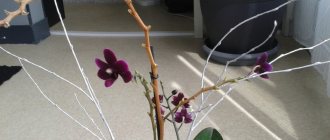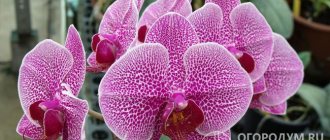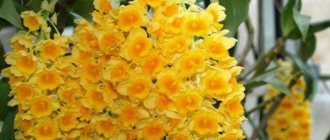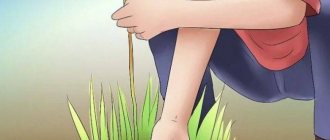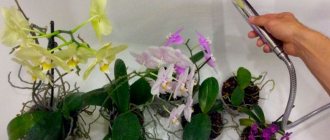Dried peduncle of phalaenopsis
Knowing an orchid grower how to prune an orchid will help him enjoy flowering almost all year round. In home breeding, the phalaenopsis orchid is most often found, which significantly outperforms other species that require a period of rest and recovery. Although not everyone agrees that it is necessary to speed up the flowering time of these plants, since the continuous production of offspring exhausts the orchid. But whether or not an orchid blooms a second time is decided only by its owner.
Is it possible to prune, is it necessary to do it?
Orchids are very beautiful ornamental plants, most often used for greenhouse planting. The most popular varieties for home planting in Russia are the following genera:
- Cattleya.
- Phalaenopsis.
- Dendrobium.
Each of them requires proper care, including timely circumcision.
Experienced flower growers believe that orchids should definitely be pruned , since they are very delicate and fragile flowers, and dead remains take away vital energy and vitamins.
It should not be overlooked that not all varieties of orchids require this, because they are capable of blooming several times on one peduncle.
Pruning is most often done with those arrows that have already dried out and definitely will not recover.
Wanda
Wanda attracts attention with her unusual leaves. They come in a variety of colors, but are most often purple. But they are all united by light specks on the leaves. In addition, some flowers have a delicate aroma. Inflorescences can be erect or pendulous. Vanda usually has many flowers, but sometimes there is one large one.
Wanda
For your information! Vanda has long and powerful aerial roots. They can reach a meter in length.
This flower is quite unusual, as it can grow outside the soil. It is very important for this orchid that air passes directly to the roots. Most often, such plants are stored in transparent containers or without them at all.
Wanda is a rather capricious specimen. It should only stand in a sunny place: on a window or balcony. Signs of lack of sun quickly appear on the leaves. Most often they appear as pale spots.
How to choose the right time?
For orchids growing in Russia, the best time is considered to be from the beginning of October to the end of November. By this time, the buds on the shoot have already faded; there should not be a single faded bud left before you start cutting off part of the peduncle. If the stem is partially dry, you must wait for it to dry completely.
Signs that pruning is necessary:
- the arrow has completely turned brown or dried out;
- a bud does not appear from a green shoot for 6 months;
Almost the most popular variety of orchid, blooming on Russian window sills, Phalaenopsis differs slightly in the time of cutting. Its arrows, as a rule, remain green after flowering, misleading inexperienced gardeners. If the goal is to quickly renew flowering, then the peduncle is cut off as soon as the last bud falls.
Since Phalaenopsis flower stalks remain green, they do not need to be cut off . But then new shoots will begin to grow from them, which will grow in all directions, since these will not be new flowers, but flower stalks. Growing in this way, a strong load will be placed on the stems, so flower growers themselves decide on the appearance of the plant.
Do I need to prune my orchid after flowering?
After the growing season, it is not always necessary to get rid of the peduncle. But you must wait until the period when you need to prune the orchid. Cupping begins only when it is completely dry. At this time, the plant is preparing for sleep. In the Russian climate, the ideal period is late autumn - late October - November.
Signs of imminent relief:
- yellowing, drilling of the flower-bearing arrow;
- drying out of the shoot;
- long period of rest (more than six months).
Important! One of the main criteria that all reserves have been used is the drying of the tip of the stem.
Many gardeners do not know how to prune an orchid for fear of harming it. But the correct procedure does not harm the plant, especially young flowers, but helps to accumulate energy reserves for the growing season.
Step-by-step instructions: how to carry out the procedure correctly?
If, after all, a decision has been made to trim the peduncle, it is necessary to carry out the procedure correctly, following the instructions on how to cut off a dry shoot so that the flower can continue to delight with its flowering.
Required Tools
Secateurs are the best tool for pruning , according to the general opinion of all florists. It almost does not injure the plant, does not leave hangnails and does not damage the leaves. It is dangerous to use other tools on such a fragile beauty.
The last resort is scissors with thick blades. It is better to wear rubber gloves on your hands to prevent juice from getting on exposed skin.
Before the procedure itself, the pruning shears are disinfected . Alcohol or bleach solution is suitable for this. If you don’t have these disinfectants, you can simply hold the blades in boiling water or on an open fire on a stove burner. This will help prevent infections from getting into the wound.
Finding the right point on a dry branch that had flowers on it
To determine the cutting point at home, the plant is first inspected. If the stem begins to become covered with dormant buds, the orchid is cut at least 1 cm above them. However, nothing may appear from there in the future, then you can completely remove the stem. Sometimes this pruning method is used for propagation.
Or trim the stem at the base, leaving a shoot 3 centimeters long. This method is usually used when the peduncle has completely dried out, when the cavity inside the arrow is clogged and it needs to be removed.
Process
Having chosen the pruning method, you can proceed directly to the process itself. Approximate cutting steps :
- Inspect the flower and determine the exact location of the cut.
- Put on gloves after washing your hands.
- Disinfect the instrument and partially the gloves.
- Without touching any extra stems, peduncles, or leaves, carefully make a cut at any angle, without tugging at the part to be cut.
- Since an infection can get through the “wound,” it must be treated. This can be done with ground cinnamon, activated charcoal or charcoal.
- If the peduncle is not pruned “at the root,” then there will be a cavity inside, which can rot from moisture entering during watering or from getting into the soil. It definitely needs to be closed. Wax or paraffin is suitable for this.
You can cut off dry leaves and stems immediately at the root, which remain like this for a long time.
Treating a damaged area on a faded arrow
Treatment of the cut site is mandatory, since an infection can get through the “wound” and it must be treated. This can be done with ground cinnamon, activated charcoal or charcoal.
Why did the peduncle dry out prematurely?
The peduncle is a temporary shoot on which flowers are located. Therefore, if it begins to dry out at the height of flowering or earlier, the reason should be found. It is necessary to determine whether watering is sufficient. The roots will tell you about it. They should be green without mold. The roots should not be wet, nor should they be dry or pale.
Any care of the root system includes washing, pruning and disinfection of the roots. If the roots are green, the plant is developing. Light silver roots indicate that the plant is on vacation.
A flooded flower needs to be transplanted into a fresh substrate after inspection and removal of diseased areas. If the problem is a lack of moisture, watering needs to be increased, but without excess. An attentive florist distinguishes well the shades of leaves, observes the condition of the roots and notices in time the slightest deviations from the norm.
Photo
Below in the photo you can see some moments of the plant pruning process:
Phalaenopsis
Phalaenopsis is a very interesting and unusual type of orchid. Its homeland is the humid forests of Southeast Asia, Australia and the Philippines. Often these flowers grow on trees, but sometimes they can be seen on stones. This orchid is quite easy to care for. Flowering is very abundant. It can be at any time of the year and lasts from 2 to 6 months. No transplant required.
Ruellia - home care and flowering options
However, the root system needs light. She uses the potty as a support. This plant does not need soil. The flowers of this plant look like hanging bells. Moreover, they can be of different colors.
Note! This flower should be trimmed very carefully. It contains poisonous juice. Contact with skin may cause burns. Therefore, during any procedure it is necessary to use rubber gloves.
This type also involves unusual pruning. There is an arrow on the peduncle; some people prefer to cut it off. Then it is placed in a glass of water, and a baby may appear on it.
Phalaenopsis
What to do with the resulting shoot?
Not all cut flower stalks should be thrown away immediately; they can still be useful, especially if you want to grow orchids.
After flowering, Phalinopsis will still be green and alive. With proper care, you can use it to propagate an orchid or grow flowers on it. To obtain a new plant from a peduncle under natural conditions, you need high humidity (70-80%) and an appropriate temperature regime (24-27 degrees).
It is necessary to water it moderately, allowing the soil to dry slightly. Lighting for a future orchid must be maintained at least 12 hours a day .
But at the moment there is simply a way to obtain a new plant from the arrow - hormonal cycotinin paste. The integumentary scales are removed from the remaining dormant bud, which is why “wounds” remain on the stem; these are the ones that need to be treated with hormonal ointment. Due to this, the drug gets inside the flower and stimulates the growth and development of the bud.
Or, with a cut peduncle, experienced gardeners carry out the cutting procedure and raise children on them:
- Having cut the arrow, cut it into several parts of 3-4 cm so that each stalk has a dormant bud.
- All resulting sections are sprinkled with activated charcoal or charcoal powder.
- For further development, cuttings are placed in a humid environment - sphagnum moss or a mini-greenhouse at a temperature of 25-30 degrees. Humidity is very important during the growth of new plants, so it must be constantly maintained.
Aganisia
Caring for irises after flowering - when to trim the leaves
Aganisia is a small species. Such orchids are found only in South Africa. A distinctive feature is the thin and long stem. The petals of the flower are white. From the outside it looks like an air cloud. Aganisia is also quite whimsical. For full growth, a large amount of light and moisture is required. Aganisia prefers bright light, but the light should be diffused. Also tolerates partial shade well. The crop usually fades at the end of summer. Pruning is required closer to the beginning of autumn.
Aganisia
First home care
For the first few days, you should not disturb the delicate flower too much , as this is a difficult “operation” for it. If pruning is carried out in the fall, this coincides with the winter dormancy phase, when the plant slows down its growth and development.
In order for the orchid to continue to bloom and delight with new flowers, you should take good care of it after circumcision:
- Water only after the substrate in the pot has completely dried.
- Do not give any fertilizing for 2-2.5 months during hibernation.
- During the day, maintain the temperature in the room no higher than 25°C, and at night – no lower than 14°C.
- Avoid drafts in the area designated for the orchid.
- Lighting should be moderate; direct sunlight should not be applied to the plant. If pruning took place in the summer, it is advisable to create a small shadow for the flower using some light translucent material.
- Do not place the flower near heating appliances.
Before you start growing flowers, you need to learn a little about them and how to grow them. Some of them require a lot of care and protection. Orchids are tropical plants of their kind; they have taken root well among flower growers around the world, including in Russia. But to make them feel at home, you need to put a lot of effort into their care.
Deadlines
Flowering shoots should be removed when the plant is preparing for a dormant period. This can be recognized by the following signs:
- Change in color of the peduncle - it becomes brown or purple.
- Its drying and withering.
- Lack of flowering for six months, despite the fact that the shoot remains green.
Typically, the resting phase of orchids occurs at the end of October-November . This is the optimal time for pruning. However, you also need to focus on the state of the flowering stem described above.
